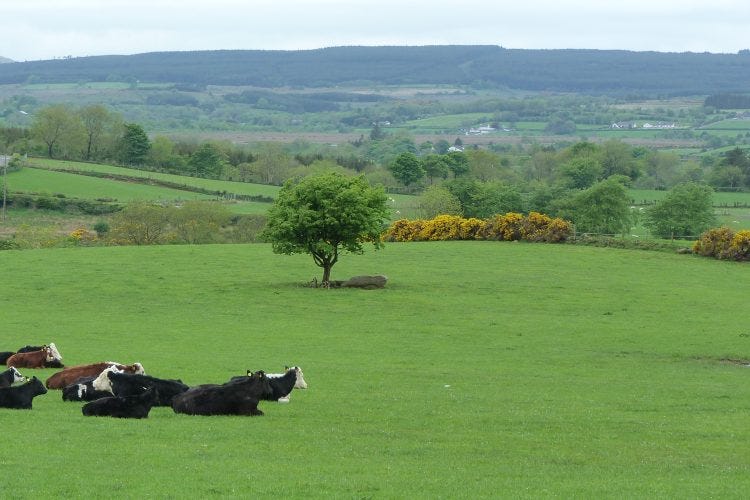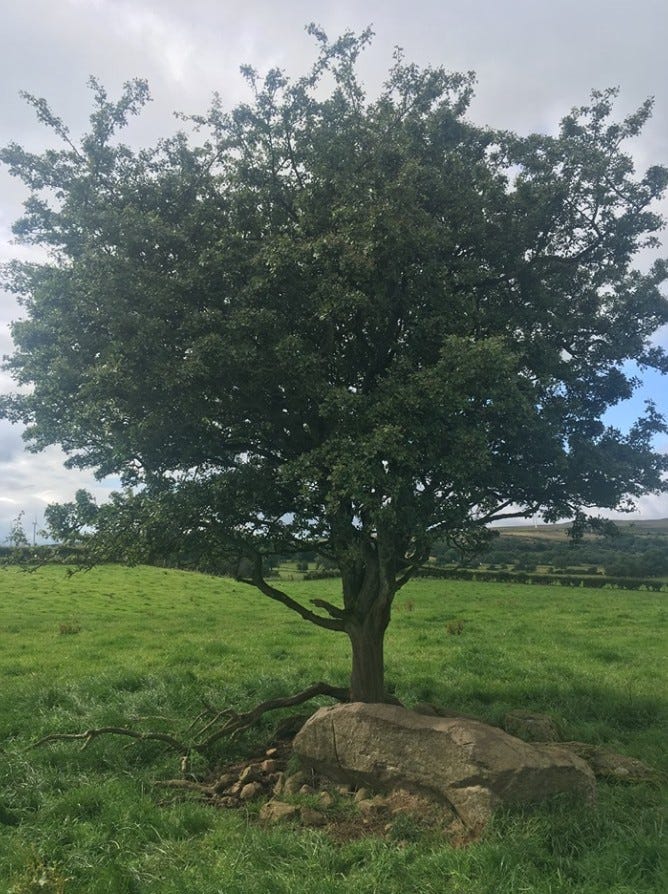Ireland's Original Vampire Was a Murderous Dwarf (And He Might Have Inspired Dracula)
The chilling true story of Abhartach—the blood-drinking tyrant who terrorized County Derry centuries before Bram Stoker put pen to paper
Hello, my lovely friends! 🕸️
So here's the thing about writing paranormal cozy mysteries: you spend hours researching folklore and legends, diving down rabbit holes that would make Alice dizzy, and occasionally you stumble across something so deliciously spine-tingling that you simply must share it with someone who'll appreciate the proper amount of gothic glee.
That's how Lore & Order: Daisy's Paranormal Casebook was born.
Every few weeks, as I'm crafting the Eldergloom Mysteries and researching the kinds of supernatural shenanigans that make small towns... interesting... I'll come across a real story that's so much stranger and more fascinating than anything I could invent. Because let's be honest—truth really is stranger than fiction sometimes, isn't it?
Now, before we dive in, let me be clear: I'm not a historian or an academic. I'm just a slightly cursed writer with an affinity for the strange and spooky, armed with an unhealthy amount of curiosity and a very patient search engine. What I am is someone who believes that the best mysteries—whether fictional or historical—deserve to be told with the perfect blend of atmospheric detail and cozy intrigue.
Think of these as paranormal cold case files, investigated with the same community-focused, detail-obsessed approach that my fictional sleuths bring to their mysteries. We'll explore the folklore, examine the evidence, and maybe—just maybe—uncover why these stories have survived centuries when so many others have been forgotten.
This first case feels particularly fitting: Slaghtaverty isn't too far from where I live, and since Dracula has been my favorite book since childhood, investigating Ireland's original vampire legend seemed like the perfect place to start our supernatural casebook.
This week in Lore & Order: Daisy's Paranormal Casebook, where we investigate the mysteries that refuse to stay buried—exploring the true stories behind paranormal legends and the justice that echoes through centuries.
📁 The Case File
Location: Slaghtaverty, County Derry, Northern Ireland
Time Period: 5th-6th Century CE
Classification: Neamh-mairbh (Walking Dead)
Status: Cold case, centuries unresolved
In the misty hills between Garvagh and Dungiven, where the Glen of the Eagle meets ancient stone, stands a monument to Ireland's oldest recorded vampire case. Not the romantic, brooding figure of modern fiction, but something far more chilling—a tale of tyranny, blood, and a justice so final it required supernatural intervention.
This is the story of Abhartach, and it might just be the most important vampire legend you've never heard of.
🏰 The Original Crime Scene
Picture County Derry in the 5th century: a patchwork of petty kingdoms where tribal warlords ruled from hill forts, and magic was as real as the morning mist. In this landscape of power and superstition lived a chieftain whose very name has become synonymous with dread.
Abhartach (Irish for 'dwarf') was described as both physically small and monstrously cruel—a magician and "dreadful tyrant" who "perpetrated great cruelties on the people." But unlike the distant tyranny of kings, Abhartach's evil was intimate, personal, woven into the daily fabric of his subjects' lives.
The first documented account comes to us from folklorist Patrick Weston Joyce in 1870, but the story itself is far older—passed down through generations who remembered when such monsters walked among the living.
💀 The Fatal Slip
The end began with jealousy. Abhartach suspected his wife of having an affair, and one night he climbed out the window of his castle to spy on her. Whether from his small stature or simply poor balance, he slipped and fell to his death.
His body was discovered the next morning, and his people—relieved that their tormentor was finally gone—quickly buried him standing upright, as befitted a chieftain's rank. They thought their nightmare was over.
They were wrong.
🩸 The Return
The very next day, Abhartach appeared, demanding bowls of his peoples' blood fresh from cuts on their wrists. The terrified clanspeople complied through sheer terror.
This wasn't the romanticized vampirism of Victorian fiction. This was extortion beyond the grave—a tyrant who had found a way to continue his cruelties even in death. The townspeople quickly contacted a neighboring chieftain named Cathán (or Cathain), begging him to deliver them from this neamh-mairbh—this walking dead.
🕵️ The Investigation Begins
Cathán agreed to help, approaching the problem like any good investigator: identify the threat, neutralize it, document the results. He waited for Abhartach and slew him, burying him again in the standing position.
But there's no keeping a good vampire down. The very next day, Abhartach returned with his empty bowl, demanding more fresh blood.
When the same result occurred after the second killing, Cathán realized he was dealing with something beyond conventional warfare. Like any skilled detective faced with an inexplicable case, he consulted an expert.
🧙 The Expert Testimony
The druid (or in some versions, an early Christian saint) told Cathán that Abhartach was one of the neamh-mairbh, the walking dead, and could only be stopped by being killed with a sword made of yew wood, buried upside down, surrounded with thorns, and sealed with a large stone.
This wasn't mere superstition—it was a precise forensic protocol for dealing with a specific type of supernatural threat. Every detail mattered: the yew wood for its sacred properties, the inverted burial to disorient the spirit, the thorns for protection, the stone to weight down the grave.
🗡️The Final Solution
Cathán followed the instructions exactly. With his yew-wood sword, he killed Abhartach a third time and buried him upside down, facing Hell, surrounded by thorns and sealed with a great stone.
The protocol worked. Abhartach never rose again.
The monument raised over the grave gave the townland its name—Slaghtaverty, from the Irish "Sleacht Abhartaigh," meaning Abhartach's grave or sepulchre.
🪦 Physical Evidence
Today, you can still visit the crime scene. Abhartach's grave is now known as Slaghtaverty Dolmen, locally called "The Giant's Grave"—ironic, considering Abhartach's small stature. It comprises a large rock and two smaller rocks under a hawthorn tree.
🧛 The Stoker Connection
Here's where our case file intersects with literary history. Stoker, a regular visitor to Oscar Wilde's home, moved in the same literary circles as Lady Wilde—who was well-versed in Irish legends, including that of Abhartach. He also had access to Joyce's 1870 account nearly two decades before Dracula was published.
Both figures are undead tyrants, both require elaborate rituals to be defeated, and both feed on the blood of the living. Even the phrase droch fhola—Irish for "bad blood"—adds a chilling linguistic echo.
⚖️ Justice Deferred, Justice Served
What makes the Abhartach case so compelling from an investigative standpoint isn't just its potential influence on vampire literature—it's the community response to injustice. When conventional authority failed (Abhartach's own position as chieftain), the people sought help from neighboring leadership. When conventional methods failed (killing him twice), they consulted experts and followed precise protocols.
This wasn't vigilante justice—it was systematic problem-solving by a community that refused to accept that evil should triumph, even from beyond the grave.
In our modern paranormal cozy mysteries, we see echoes of this same pattern: small communities where everyone knows everyone, where folk wisdom is as valuable as forensic science, where the real solution often comes from understanding both the practical and the mystical aspects of a case.
🔍 Lessons for Modern Investigators
What can contemporary paranormal investigators learn from this case?
Community Matters: The people of Slaghtaverty didn't suffer in silence. They reached out for help and worked together toward a solution.
Expertise is Essential: When conventional methods failed, Cathán consulted those with specialized knowledge rather than continuing to repeat ineffective approaches.
Precision Counts: Every detail of the final protocol mattered. Half-measures would have failed.
Documentation Preserves Knowledge: Joyce's careful recording of the legend ensured that future generations could learn from this case.
Some Graves Should Stay Closed: Modern incidents at the burial site suggest that certain cases, once solved, should remain that way.
🕯️ A Final Note from the Files
Here's a deliciously eerie postscript: according to local tradition, the land where Abhartach lies is considered "bad land"—cursed ground that refuses to be tamed. Bob Curran reports that when attempts were made to clear the area and chop down the hawthorn tree, chainsaws inexplicably kept cutting out. On another occasion, when workmen tried to remove the great stone, the chain snapped and one worker suffered a severe cut to his hand. His blood soaked into the ground and disappeared immediately, and witnesses swore they felt the earth shake beneath their feet.
Perhaps some investigations are best left undisturbed. After all, Slaghtaverty has slept peacefully for over a thousand years—why risk waking what's been so carefully contained?
Sweet dreams, my lovely coven.
Daisy🌙
🕯️✨ Help Pick the Next Case! Have a local legend, haunted tale, or paranormal oddity you'd like me to investigate? Send your story to the casebook—I'm always hunting for folklore with bite. The more gothic, the better. 🖤
📬 Drop me a line or leave a comment below.
🗺️ Should we stay in Ireland next time, or take our ghost-hunting abroad?
🔍 Join the Investigation If you enjoyed this tale of eerie injustice and gothic intrigue, come haunt my inbox:
📚 Start with a free paranormal cozy mystery 🐾 Claws, Collars & Curses – available here: https://BookHip.com/HLBVKRD
🛒 See all my mysteries on Amazon 🕸️ amazon.com/author/daisygraves
💌 Subscribe for more paranormal case files (and updates on new Eldergloom Mysteries):
Sources and Further Reading:
Joyce, Patrick Weston. The Origin and History of Irish Names of Places (1870)
Curran, Bob. Vampires: A Field Guide to the Creatures That Stalk the Night
NI Community Heritage Archive. "Slaghtaverty." https://niarchive.org/projectitems/19-slaghtaverty/
The Giant’s Grave: https://mcgunnegalchronicles.wordpress.com/2023/04/30/the-giants-grave/
Various Irish folklore collections and contemporary investigations







